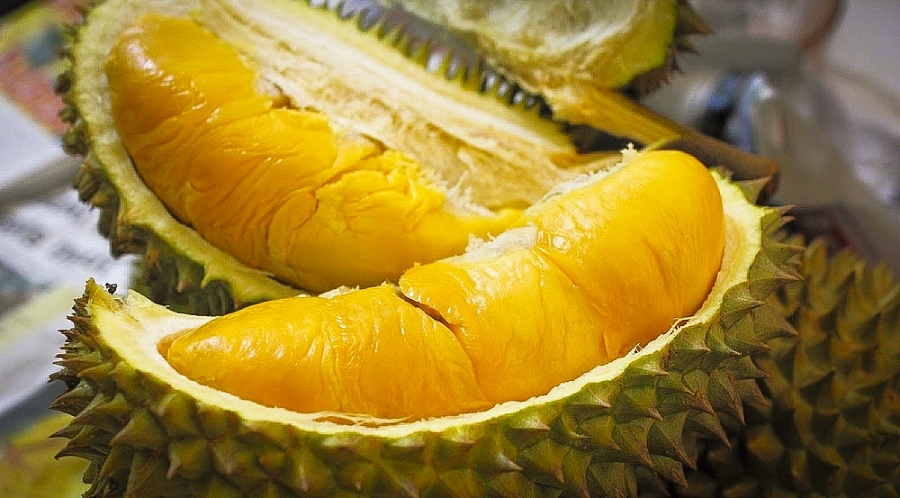Agricultures, Foods, News & Event
In 2024, durian exports will reach 2 – 2.5 billion USD
If by 2024, Vietnamese durian has an additional growing area code issued by Chinese authorities, the ability to export durian can reach 2 – 2.5 billion USD.
According to records in the Southwest region, the beautiful Ri6 durian today, September 5, 2023, is priced at about 55,000 – 59,000 VND/kg; Durian Ri6 bucket is priced at about 45,000 – 52,000 VND/kg, flat compared to the previous day.
In the Southeast region and Central Highlands, beautiful Ri6 durian on September 5, 2023 costs about 55,000 – 58,000 VND/kg; Ri6 durian is priced at about 45,000 – 50,000 VND/kg, flat compared to the previous session.

Thai durian beautiful fruit on September 5, 2023 recorded a decrease of 5,000 VND/kg compared to September 4 and dropped to 80,000 – 85,000 VND/kg. At the same time, the price of Thai durians also recorded a decrease of 5,000 VND/kg, currently being purchased by traders at 70,000 – 78,000 VND/kg. This is also the price of Thai durian (two beautiful types, choose and buy in buckets) recorded generally in the Southeast and Central Highlands provinces.
Meanwhile, in Dak Lak, durian harvest begins. Durian traders and storks spread throughout the gardens to sell goods at high prices. According to gardeners, Ri6 products sometimes increase to 60,000 – 62,000 VND/kg, Thai products cost 90,000 VND/kg.
As for Dak Nong, some areas have entered the end of the harvest season but prices are still increasing. Currently, the price of Thai durian “jumps” to 90,000 – 100,000 VND/kg depending on the type.
Previously, in early August 2023, Thai durian was purchased at the garden for 70,000 – 80,000 VND/kg.
Mr. Dang Phuc Nguyen, General Secretary of the Vietnam Fruit and Vegetable Association, informed that durian prices in the Central Highlands region have increased to a record high. The reason is that, currently, our country is the only one left with durian to harvest, other countries such as Thailand and Malaysia are out of season.
“This is the advantage of Vietnamese durian when exporting officially to the Chinese market. Other countries only have a certain durian season a year, while in Vietnam, we spread the crop and harvest all year long,” Mr. Dang Phuc Nguyen said.
Specifically, the durian season in Vietnam starts in March, the southwestern region enters the main season and lasts until May; April – July is the main durian season in the Southeast region; From July to October is the main season of the Central Highlands region; From November to March of the following year, durian off-season in the West is harvested.
According to data from the General Department of Customs, in the first 8 months of 2023, durian exports earned nearly 1.3 billion USD, leading the export turnover of fruits and vegetables. With this export momentum, Mr. Dang Phuc Nguyen forecasts that durian exports are likely to bring in 1.6 – 1.7 billion USD.
China is the world’s largest durian consumer market, with import turnover reaching several billion USD each year. China has also experimented with growing durian in Hainan. There are currently many different opinions surrounding this fruit.
Regarding this, Mr. Dang Phuc Nguyen assessed that China’s durian cultivation may not necessarily produce fruit, and having fruit may not necessarily be delicious. Because durian trees are picky about soil and climate, too much sun or too much rain is not good. Growing durian in areas without water will be very difficult. China grows in Hainan, this is an area that suffers from many storms, shaking trees will make it difficult to set fruit and keep fruit. It takes 10 years to be successful.
“Philippine and Thai durians are only available seasonally, while Malaysia is only exported to the Chinese market as frozen products. If we do a good job in growing areas and packaging, in the next 10 years our country will not need to worry about the market for durian,” said the leader of the Vietnam Fruit and Vegetable Association.
If by 2024, Vietnamese durian has more growing area codes issued by Chinese authorities, the ability to export durian reaches 2 – 2.5 billion USD.
Also according to Mr. Dang Phuc Nguyen, currently, Thailand is cutting down a lot of mangosteen to switch to growing durian. Cambodia also grows durian. If Vietnam doesn’t plant, it will lose its opportunity.
The advantage of Vietnamese durian is that it is available all year round. Plus, we have the advantage of shipping time. “First in distance, second in speed”, the transportation distance is short, so the logistics cost of bringing durian to China in our country is much cheaper than that of competitors in Thailand and Malaysia.
Vietnamese durian products not only compete in quality but also compete with Thai durian in price.
The worldwide durian market must be several tens of billions of dollars. As for the Chinese market, a few years ago they imported 4 billion USD/year, this number increased because previously they mainly took Thai goods (Thailand supplied 90% to the Chinese market).
The market absorption of durian fruit in this market is still large, because the amount of durian they previously imported from Thailand could only serve the needs of about 200 – 300 million people. In other words, only a portion of consumers in China can eat durian due to the expensive price of this fruit.
With a Chinese market of 1.4 billion people, quality and affordable Vietnamese durian will serve a large number of Chinese consumers.
Source: https://congthuong.vn/nam-2024-xuat-khau-sau-rieng-se-dat-2-25-ty-usd-270499.html

